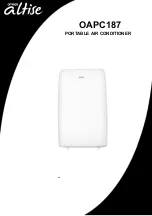
Page 57
C1 DIAGRAM WITH B9 AND A16 DIAGRAMS
Electromechanical Thermostat Connected to CHA16-1853 with Typical Electric Heat Unit (and Without Economizer)
A-CHA16-1853
This flowchart is used to show the step by step sequence that takes place
when thermostat demand is sent to the CHA16. The sequence describes the
actions of devices in the unit which control blowers, fans and other compo
nents in the system.
Operation Sequence: C1 Section B9 and A8 Sections
(Electromechanical Thermostat wired to CHA16-1853)
Power:
1- When the unit disconnect closes, line voltage energizes both transformers
T1 and T2. Transformer T1 provides 24VAC power to unit cooling and blow
er controls and thermostat. Transformer T2 provides 24VAC power to unit
heating controls.
2- If the unit is 575V and is equipped with optional PED16 exhaust fans, line
voltage simultaneously energizes transformer T10. Transformer T10 pro
vides 460VAC power to PED16 fan motors and is switched through relay
K65 (NOTE-PED16 fan motors use line voltage in all units except 575V
models).
Pilot Relays:
3- All thermostat demand is switched via pilot relays located on pilot relay board
A11. A11 is used to reduce voltage drop caused by long runs of thermostat
wire or undersized thermostat wire.
Blower Operation:
4- Blower demand from thermostat terminal G energizes pilot relay K46. Nor
mally open K46-1 contacts close.
5- When K46-1 closes 24VAC power is routed through N.C. K9-1 contacts to
energize blower contactor K3 (and mercury exhaust switch S39 if optional
PED16 is installed).
6- When K3 is energized K3-1 closes to energize blower motor B3 and K3-2
closes to energize the economizer damper motor (if economizer is installed,
outdoor damper drives to minimum position).
7- Optional REMD16 and PED16 installed: As the economizer damper drives
open, mercury switch S39 closes and relay K65 is energized.
8- When K65 is energized, K65-1 closes to energize both PED16 exhaust fan
motors B10 and B11.
1st Stage Cooling(compressors B1 and B2 operate separated by delay):
9- Cooling demand energizes Y1 and G in the thermostat. G energizes pilot
relay K46. See step 5 and subsequent steps for blower operation. After a
delay from DL8 (30 second on delay, 240 second off delay), Y1 energizes
pilot relay K66. Normally open K66 contacts contacts close.
10- When K66-1 closes, 24VAC power is routed through low ambient thermo
stat S3, high temperature limit S49, high pressure limit S4 and low pressure
limit S24 to energize compressor contactor K1.
11- Contactor K1-1 contacts close to energize compressor B1.
12- Simultaneously when K66-1 closes, time delay DL15 and contactor K10
are energized. DL15 initiates a 30 second delay before closing. K10-1
closes to energize both condenser fan motors B4 and B5.
13- After 30 second delay has elapsed, DL15 closes and 24VAC power is
routed through high temperature limit S50, high pressure limit S7 and low
pressure limit S25 to energize compressor contactor K2.
14- Contactor K2-1 contacts close to energize compressor B2. K2-2 auxilia
ry contacts close to bypass (latch) DL15.
2nd Stage Cooling(compressor B13 operates in addition to B1 and B2):
15- Additional cooling demand energizes Y2 in the thermostat. After a delay
from DL9 (30 second on delay, 240 second off delay), Y2 energizes pilot
relay K67. Normally open K67 contacts close.
16- When K67-1 closes, 24VAC power is routed through high temperature limit
S53, high pressure limit S28 and low pressure limit S34 to energize com
pressor contactor K14.
17- Contactor K14-1 closes to energize compressor B13.
1st Stage Heating Operation:
18- Heating demand energizes W1 in the thermostat. W1 energizes pilot relay
K77. Normally open K77-1 contacts close.
19- When K77-1 closes the 1st stage heating pilot relay (K9) is energized.
K9-1 normally open contacts switch closed (and normally closed con
tacts switch open) and K92 and K93 normally open contacts switch
closed.
20- When K91 switches, blower contactor K3 (and mercury exhaust switch
S39 if optional PED16 is installed) is energized.
21- When K92 switches closed, 2nd stage electric heat is enabled.
22- When K93 closes, electric heat operation begins. The operation se
quence of electric heat units varies depending on size (kW input rating)
and line voltage rating.
23- When K3 is energized K3-1 closes to energize blower motor B3 and K3-2
closes to energize the economizer damper motor (if economizer is installed,
outdoor damper drives to minimum position).
2nd Stage Heating Operation:
24- Additional heating demand energizes W2 in the thermostat. W2 ener
gizes pilot relay K49. Normally open K49-1 contacts close.
25- When K49-1 closes, demand passes through K92 (2nd stage enable
contacts) to energize the 2nd stage heating pilot relay. The operation
sequence of electric heat units varies depending on size (kW input rat
ing) and line voltage rating.
Safety Blower Operation:
26- If either the primary or secondary limits in the electric heat section trip, the
heating elements are immediately deenergized.
27- The indoor blower remains energized powered by K9 which is ener
gized by thermostat demand.
Содержание CHA16
Страница 47: ...Page 47 FIGURE 52 CYCLE CONTROL KIT WIRING DIAGRAM...
Страница 55: ...Page 55 NOTES...
Страница 58: ...C1diagram electromechanical thermostat with modulating economizer with D5 diagram Page 58...
Страница 60: ...C2 1 diagram electromechanical thermostat with modulating economizer and warm up with D5 diagram Page 60...
Страница 62: ...Page 62 B41 diagram with C1 diagram CHA16 2553 2753 3003 Operating Sequence...
Страница 64: ...Page 64 B9 diagram with C1 diagram CHA16 1853 Operating Sequence...
















































